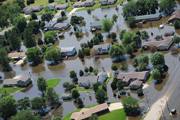Floodplain acquisitions offer many benefits. As Dr. Rebecca Kihslinger explained in a previous post, buyout properties can be transformed from flood-prone subdivisions and vulnerable riverfront businesses into community gardens, biking trails, and natural habitats. And by acquiring flood-prone properties, local governments can spare families and business owners the heartbreak that accompanies seeing one’s home or livelihood submerged.
Beyond mitigating flood risk, restoring habitats, and increasing community amenities, acquiring flood-prone properties can also provide an economic boon. The Federal Emergency Management Agency (FEMA) reports that investments in floodplain buyouts consistently yield returns of well over 200%. Another cost-benefit analysis study shows that, from 1993 to 2003, governments saved an average of $5.10 for every $1 spent on floodplain acquisitions.
 Success stories can be found throughout the United States. Shepherdsville, Kentucky, located in Bullitt County on the frequently-flooded Salt River, is especially prone to rising waters. In this small town south of Louisville, floods wreaked havoc in 1997 and damaged a substantial amount of property—$30 million worth of damage in Bullitt County alone. In 1998, hoping to mitigate future disasters, state and local officials used FEMA grants to buy floodplain properties. These purchases were prudent. After estimating the amount of damage that would have occurred in subsequent floods, a report by the University of Kentucky concluded that for every dollar spent on acquisitions, $2.45 has been realized. In place of the damaged structures, a new park—complete with trails, recreation equipment, and softball fields—now stands.
Success stories can be found throughout the United States. Shepherdsville, Kentucky, located in Bullitt County on the frequently-flooded Salt River, is especially prone to rising waters. In this small town south of Louisville, floods wreaked havoc in 1997 and damaged a substantial amount of property—$30 million worth of damage in Bullitt County alone. In 1998, hoping to mitigate future disasters, state and local officials used FEMA grants to buy floodplain properties. These purchases were prudent. After estimating the amount of damage that would have occurred in subsequent floods, a report by the University of Kentucky concluded that for every dollar spent on acquisitions, $2.45 has been realized. In place of the damaged structures, a new park—complete with trails, recreation equipment, and softball fields—now stands.
According to a report from the Center for American Progress, communities in Missouri and Iowa experienced similar benefits. Analyzing the impact of buyouts from 1999 to 2008, “FEMA and the State of Missouri found that for the 885 properties for which there were adequate data, nearly $97 million in losses were avoided during 14 flood disasters, representing a 212 percent return on investment for the $44 million of public funds that had been invested in those particular buyouts.” In Iowa, officials concluded that “the buyout of 703 floodplain properties in 12 of the state’s communities between 1988 and 2008 yielded a 219 percent return on investment following the floods of 2008 alone, representing an average of $140,408—in 2008 dollars—in total losses avoided for each property.” Comparable economic benefits can be seen in other communities, too.
With such a clear financial upside, it’s easy to see why some state and local governments embrace floodplain acquisitions. Still, finding sufficient funding to purchase properties from willing sellers is a major challenge.
Currently, primary funding for acquisition comes from an array of state-administered federal grant programs, plus matching funds from state and local governments. FEMA’s Hazard Mitigation Grant Program is the primary source of federal funding. Additional funding comes from the Department of Housing and Urban Development’s Community Development Block Grant (CDBG), as well as FEMA’s Pre-Disaster Mitigation (PDM) Grant Program. Additionally, local governments often partner with land trusts and other nonprofits to leverage these funds for additional investments to protect their communities, their pocketbooks, and thousands of flood-prone properties.
Proposed cuts in the new administration’s 2018 budget, however, eliminate the CDBG and cut funding to the PDM. Additionally, the budget proposes eliminating the Flood Hazard Mapping Program, which defines areas that are at risk of flooding. Without these programs, acquiring flood-prone properties will become much harder for state and local governments. Many families will be stuck in risky areas, increasing the chances that they need to be rescued from rushing waters. Potential parks, trails, and natural habitats won’t materialize. Future public dollars—many of them—will be spent instead of saved.
There are many reasons to support floodplain acquisitions. Nature-enthusiasts can get on board, as can community members who want to increase outdoor recreation opportunities. And with careful study, economists and budget-builders can, too. Spending more now could save us billions in the future. If we do decide to reduce funds for floodplain acquisitions, the next major disaster could drown us—in debt.
The proposed 2018 budget can be found here.
